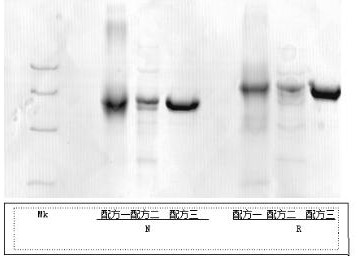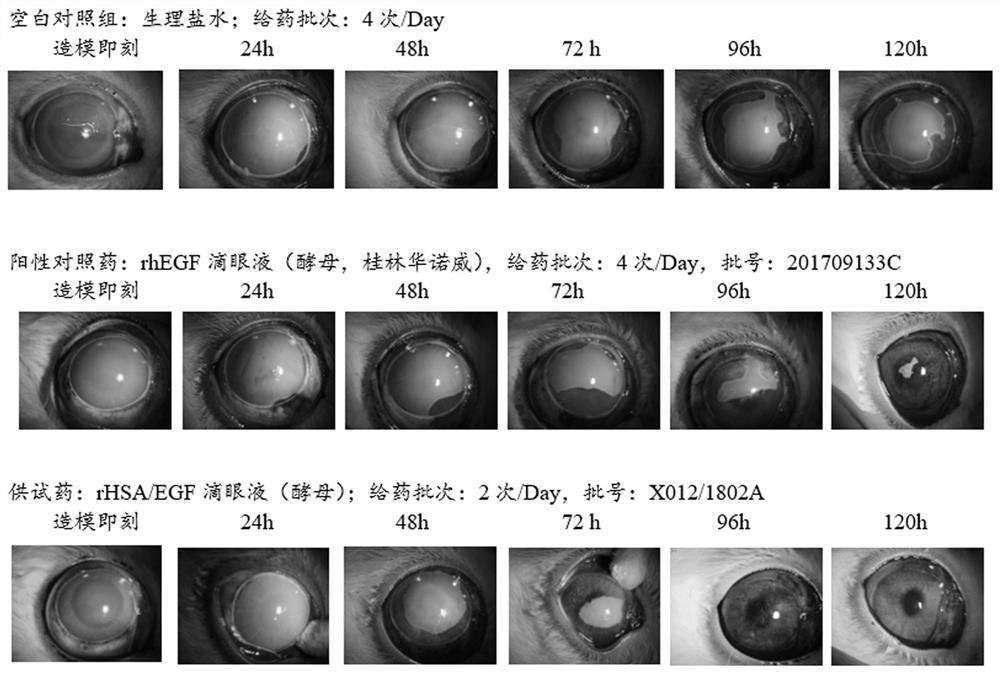A temperature-sensitive gel damage repair preparation and its application
A temperature-sensitive, damage-repairing technology that can be used in sensory diseases, aerosol delivery, medical preparations with inactive ingredients, etc.
- Summary
- Abstract
- Description
- Claims
- Application Information
AI Technical Summary
Problems solved by technology
Method used
Image
Examples
Embodiment 1
[0062] A kind of preparation formula three containing rHSA / EGF
[0063] In view of the fact that adding glycerol or adding CMC at the same time in Comparative Example 1 and Comparative Example 2 did not significantly improve the stability of the fusion protein, for this reason, glycine plus poloxamer was used as a protein stability and to increase the viscosity of eye drops. The preparation formula excipients, see Table 3 for details.
[0064] Table 3 A formulation three containing rHSA / EGF
[0065]
[0066] Prepare 4ml / bottle×10 bottles of samples. According to the method described in Comparative Example 1, it was placed in an accelerated test box with a temperature of 25°C and a humidity of 70% to accelerate the stability inspection for 14 days, and samples were taken according to time points for appearance inspection, biological activity measurement and protein electrophoresis detection.
[0067] The results are shown in Table 4.
[0068]
[0069] When testing, the...
Embodiment 2
[0079] A kind of thermosensitive type gel formulation formula five
[0080] In order to achieve the goal that the eye drops are in a liquid state at 0-35°C and in a gel state above 35°C (significantly reducing the fluidity of the eye drops), on the basis of formulation 4, the poloxamer 188 and the consumption of poloxamer 407, specifically see Table 6.
[0081] Table 6 Temperature-sensitive gel preparation formula five
[0082] Component No. name Dosage use 1 rHSA / EGF 0.2mg / mL API 2 Glycine 2% stabilizer 3 Poloxamer 188 6% thickener 4 Poloxamer 407 16.5% thickener 5 100mM PB to a final concentration of 10mM buffer
[0083] Prepare 4ml / bottle×10 bottles of samples. According to the method described in Comparative Example 1, it was placed in an accelerated test box with a temperature of 25°C and a humidity of 70% to accelerate the stability inspection for 14 days, and samples were taken according to time points...
Embodiment 3
[0086] A kind of temperature-sensitive gel formulation formulation formulation six
[0087] In order to achieve the goal that the eye drops are in a liquid state at 0-35°C and in a gel state (no fluidity) above 35°C, on the basis of formulation five, further adjusting Poloxamer 188 and Poloxamer For the amount of 407, see Table 7 for details.
[0088] Table 7 temperature-sensitive gel preparation formulation formulation six
[0089] Component No. name Dosage use 1 rHSA / EGF 0.2mg / mL API 2 Glycine 2% stabilizer 3 Poloxamer 188 6% thickener 4 Poloxamer 407 18% thickener 5 100mM PB to a final concentration of 10mM buffer
[0090] Prepare 4ml / bottle×10 bottles of samples. According to the method described in Comparative Example 1, it was placed in an accelerated test box with a temperature of 25°C and a humidity of 70% to accelerate the stability inspection for 14 days, and samples were taken according to time poi...
PUM
 Login to View More
Login to View More Abstract
Description
Claims
Application Information
 Login to View More
Login to View More - R&D
- Intellectual Property
- Life Sciences
- Materials
- Tech Scout
- Unparalleled Data Quality
- Higher Quality Content
- 60% Fewer Hallucinations
Browse by: Latest US Patents, China's latest patents, Technical Efficacy Thesaurus, Application Domain, Technology Topic, Popular Technical Reports.
© 2025 PatSnap. All rights reserved.Legal|Privacy policy|Modern Slavery Act Transparency Statement|Sitemap|About US| Contact US: help@patsnap.com



